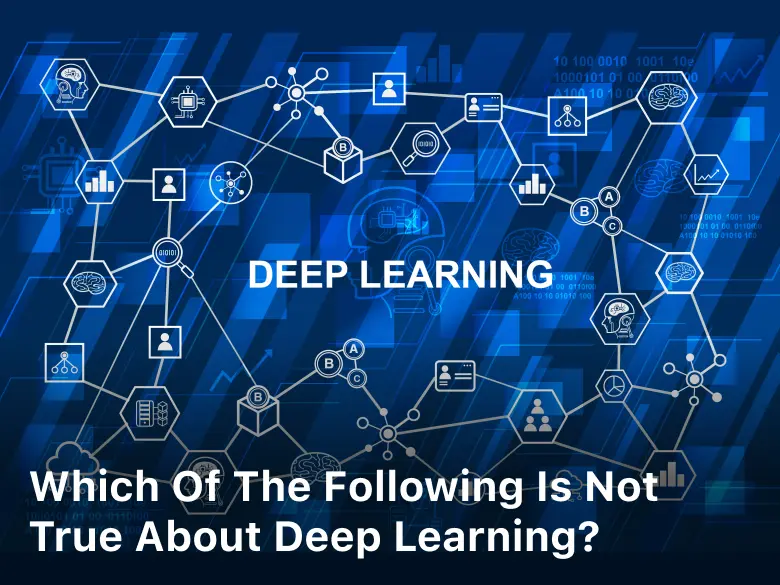
Which of the Following is Not True About Deep Learning?
Which of the Following is Not True About Deep Learning? Discover what’s true and false about deep learning in this comprehensive guide. Explore FAQs and expert insights in plain English.
Deep learning, a subset of artificial intelligence (AI), has garnered immense attention in recent years. As the field continues to evolve, it’s crucial to separate fact from fiction. In this article, we’ll delve into common misconceptions and provide you with a deep understanding of the truths behind deep learning.
Which of the Following is Not True About Deep Learning?
Deep learning has revolutionized AI applications, from image recognition to natural language processing. However, amidst the excitement, several myths and misconceptions have emerged. This article aims to clarify these notions and offer expert insights into what’s true and what’s not about deep learning.
Myth 1: Deep Learning Understands Like Humans
One of the most common misconceptions about deep learning is that it possesses a human-like understanding of the world. It’s easy to see why this misconception arises—deep learning models can accomplish incredibly sophisticated tasks, from recognizing faces in photographs to translating languages in real time. However, it’s essential to clarify that this is not the same as understanding in the way humans do.
How Deep Learning Works:
At its core, deep learning relies on artificial neural networks, which are inspired by the structure of the human brain. These networks consist of interconnected nodes, each performing simple mathematical operations.
Through a process called training, deep learning models learn to adjust the strengths of these connections (weights) to make accurate predictions or classifications based on input data.
The Key Differences:
No Consciousness: Unlike humans, deep learning models lack consciousness or self-awareness. They do not have thoughts, feelings, or subjective experiences. They process data purely as mathematical computations.
Pattern Recognition: Deep learning excels at pattern recognition. It can identify complex patterns in data, such as recognizing a specific face in a photograph or understanding the context of a sentence. However, this recognition is based on statistical correlations, not true understanding.
No Common Sense: While deep learning models can excel in specific tasks, they lack common-sense reasoning. For instance, a deep learning model might correctly identify a cat in an image but may not understand why cats chase mice or what a cat’s purring signifies.
Lack of Contextual Understanding: Deep learning models operate in isolation. They don’t possess the ability to understand context in the way humans do. For example, they may struggle to understand jokes, idioms, or metaphors.
Human Understanding vs. Deep Learning:
Human understanding is a product of our complex brains, which not only process information but also integrate it with our vast knowledge, memories, and experiences.
When a person understands something, they can explain it, reason about it, and apply that understanding to novel situations. Humans possess abstract thinking, creativity, and the ability to extrapolate knowledge to new domains—qualities that deep learning models lack.
Why the Misconception Persists:
The misconception that deep learning understands like humans persists because of the impressive results achieved by these models. They can process vast amounts of data quickly and accurately, leading to the illusion of comprehension. Additionally, media portrayals and science fiction often anthropomorphize AI, contributing to the belief that it possesses human-like cognitive abilities.

Myth 2: Deep Learning Equals Human-Level Intelligence
The myth that deep learning is equivalent to human-level intelligence is a common misconception in the field of artificial intelligence. It’s crucial to clarify this myth and understand the distinctions between deep learning and the complex cognitive abilities that characterize human intelligence.
Understanding the Scope of Deep Learning:
Deep learning is a subfield of artificial intelligence (AI) that focuses on training artificial neural networks to perform specific tasks. These tasks can be remarkably sophisticated, such as image recognition, natural language processing, and playing complex games like chess or Go. Deep learning models, particularly deep neural networks, have achieved remarkable successes in these domains.
The Limitations of Deep Learning:
While deep learning models can excel in specific tasks, they do not possess the breadth and depth of human intelligence. Here’s why:
Narrow Expertise: Deep learning models are highly specialized. They are trained on specific datasets and excel within the constraints of that training data. In contrast, human intelligence is general and adaptable, allowing individuals to apply their knowledge and skills across a wide range of domains.
Lack of Common Sense: Deep learning models lack common-sense reasoning, a fundamental aspect of human intelligence. Humans can make sense of ambiguous situations, understand cause-and-effect relationships, and apply knowledge to unfamiliar scenarios. Deep learning models struggle with these aspects of cognition.
Abstract Thinking: Human intelligence involves abstract thinking, creativity, and the ability to extrapolate knowledge to novel situations. Humans can solve problems that require innovative solutions, whereas deep learning models rely on patterns within existing data.
Contextual Understanding: Deep learning models operate in a context-free manner. They process data based on statistical patterns but may struggle to grasp the nuanced context of a situation. Humans excel at understanding context, irony, humor, and the subtleties of human communication.
Ethical and Moral Judgment: Deep learning models lack the capacity for ethical and moral judgment. Human intelligence allows individuals to make ethical decisions, consider the consequences of their actions, and act in alignment with values and principles.
Why the Myth Persists:
The myth that deep learning equals human-level intelligence persists for several reasons:
Media Portrayal: Popular media often sensationalizes AI achievements, creating the impression that AI systems possess human-like cognitive abilities.
Success in Specific Tasks: Deep learning has achieved groundbreaking results in tasks like image recognition and language translation, leading some to assume it has human-like intelligence.
Anthropomorphism: People tend to anthropomorphize technology, attributing human characteristics to AI systems. This can blur the line between machine capabilities and human cognition.
The Importance of Recognizing the Distinction:
Understanding the differences between deep learning and human intelligence is essential for responsible AI development and deployment. While deep learning has transformative potential, it is a tool created and controlled by humans.
It lacks the autonomy, consciousness, and holistic thinking associated with human intelligence. Recognizing these distinctions helps manage expectations and informs ethical decision-making in AI.
Myth 3: Deep Learning Doesn’t Require Data
One prevalent myth surrounding deep learning is the belief that it doesn’t require substantial amounts of data to function effectively. This misconception stems from the remarkable capabilities of deep learning models and their ability to perform complex tasks, such as image recognition and language translation. However, it is crucial to dispel this myth and emphasize the indispensable role of data in the world of deep learning.
The Role of Data in Deep Learning:
Deep learning models, particularly deep neural networks, are data-hungry by design. They learn from data patterns, adapt their internal parameters (weights), and improve their performance through a process known as training. The quality and quantity of data are fundamental factors influencing the success of deep learning models.
Key Points to Consider:
Training Data: Deep learning models require vast amounts of training data to generalize effectively. This means that they can make accurate predictions or classifications on new, unseen data. For instance, a deep learning model trained on millions of images can identify objects in photographs accurately.
Diverse Data: The data used for training should be diverse and representative of the real-world scenarios the model is expected to encounter. Diversity helps the model handle a wide range of situations.
Data Preprocessing: Before training, data often requires preprocessing to remove noise, correct errors, and ensure uniformity. Preprocessing plays a crucial role in model performance.
Why the Myth Persists:
The myth that deep learning doesn’t require data persists for several reasons:
Media Simplification: In media coverage, the complexity of deep learning is often simplified. This can lead to misunderstandings about the role of data.
Focus on Model Architecture: Deep learning models have become more sophisticated over time, with many layers and parameters. The attention on model architecture sometimes overshadows the importance of data.
Success Stories: When deep learning models achieve remarkable results, it may appear that they do so effortlessly, obscuring the extensive data collection and preprocessing efforts behind the scenes.
The Reality:
In practice, deep learning models are data-driven. The quality, quantity, and relevance of data profoundly influence their performance. Without sufficient data, these models may struggle to generalize, resulting in poor accuracy and limited usefulness. Moreover, the continuous improvement of deep learning models often relies on the availability of more diverse and comprehensive datasets.
Myth 4: Deep Learning is Infallible
The myth that deep learning is infallible is a misconception that can lead to unrealistic expectations about the capabilities of artificial intelligence (AI) systems.
Deep learning has made significant advancements and achieved remarkable results in various applications, but it is essential to recognize its limitations and the potential for errors.
Myth 5: Deep Learning Eliminates the Need for Human Intervention
The myth that deep learning eliminates the need for human intervention is a misconception that can have significant implications, especially in the development and deployment of artificial intelligence (AI) systems.
While deep learning has made substantial advancements, it is crucial to understand that human expertise and oversight remain essential throughout the AI lifecycle.
The Reality:
In reality, human intervention is not only necessary but also vital for the responsible development and deployment of AI systems. While AI can automate many tasks and improve efficiency, it cannot replace human judgment, ethics, and creativity.
FAQ
Q: Can deep learning models think like humans?
Deep learning models do not possess human-like thinking. They process data through mathematical operations and lack consciousness.
Q: Is deep learning the same as artificial general intelligence (AGI)?
No, deep learning is a specialized technique within AI. AGI aims to replicate human intelligence comprehensively.
Q: Can deep learning models operate without large datasets?
Deep learning models require substantial data for training. Insufficient data can lead to poor performance.
Q: Are deep learning models always accurate?
Deep learning models can be highly accurate but are not infallible. They may make mistakes in specific scenarios.
Q: Does deep learning replace human involvement in AI projects?
Human expertise remains crucial for AI project success, including data preparation, model evaluation, and ethical considerations.
Q: How can I learn more about deep learning?
To deepen your understanding of deep learning, explore online courses, research papers, and engage with AI communities.
Conclusion
In conclusion of Which of the Following is Not True About Deep Learning, deep learning is a powerful tool within the AI landscape, but it’s essential to debunk myths and misconceptions.
By separating fact from fiction, we can harness the true potential of deep learning. Remember, while it’s not true that deep learning equals human intelligence, it has incredible potential when used correctly.





